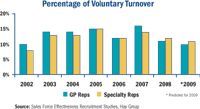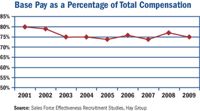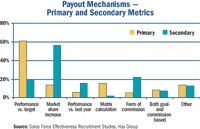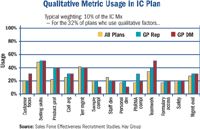Tearing Up the Rule Book
Sales compensation practices are due for an overhaul in 2010.
As a new decade unfolds, pharmaceutical manufacturers must straddle two worlds: one that features the legacy commercial model directed to prescribers, and another that embraces a new model focused on payers and other key stakeholders. As companies experiment with ways to engage a broader set of decision makers, they're envisioning new roles and organizational structures. According to Hay Group's 19th annual Sales Force Effectiveness Study, this is still an emerging phenomenon; the industry's sales administration and compensation functions are still rooted in the legacy model that prizes reach and frequency in physician contact.
The data in this survey paints a picture of the status quo for many study participants, but change is coming rapidly for others. But the data do not tell the whole story. The first movers have changed their selling model: Resources are being redeployed, emphasis is being given to account management, and the traditional selling and promotion model is being redesigned. These are exciting times for the life sciences industry: it is reshaping how it adds value at the commercial level, and the best players will use this transition as an opportunity to re-shape how the industry uses the selling and distribution channel. It follows that they must also develop fresh compensation plans built on different measures of performance.
While many senior executives are making plans to revolutionize their commercial organizations, data suggest that the implications for performance measurement and compensation are being left to implementation. While senior executives are addressing the fundamental direction of their companies, a roadmap does not yet exist. This presents both an opportunity and a threat for sales and marketing.
Rightsizing the Sales Force
The painful headlines about pharmaceutical companies reducing field sales forces are no longer standard news fare. Having cut 10 to 20 percent over the past two years, companies are now leaner, and their expenses are more in line with lower growth expectations. In fact, half of the companies participating in the survey report that they've seen little or no change in the size of their sales force over the past year. A third of survey participants said that their sales force actually grew during that time frame.

Figure 1
The continuing need to right-size is, however, very much tied to organization type. Large pharmaceutical companies are dramatically more likely than small or mid-sized companies to state that they still have too many sales reps. (See Figure 1.) This is a leading indicator of changes coming to how these organizations go to market.
New Talent Pool
As companies populate new commercial models aimed at different stakeholders, the survey foresees a period of additional staffing upheaval. While the new models may not lead to a change in the absolute number of sales reps, they will most certainly elicit a call for swapping out reps with one set of skills for new hires with a different set of skills. There will still be a need for sales reps that fit today's profile (particularly in some therapeutic areas), but these will gradually become the minority. Today, the ratio of sales reps to reimbursement specialists is 80/20; we would not be surprised to see the opposite within just a couple of years.
Several roles are emerging to correspond with three basic channels of influence in the market; among them:
Reimbursement Specialists will function as business partners to payers, be they public or private. They will be versed in health outcomes and economics research, and will be able to speak payers' language.
» Clinical Science Consultants will be responsible for implementing marketing programs that increase awareness of particular diseases or whole therapeutic areas. With advanced science degrees (PharmD, MD, PhD), these consultants can provide the clinical knowledge needed to increase recognition, diagnosis, and treatment of key disease entities.
» Key Account Managers will manage accounts with large, national institutions that drive significant sales volume. They will need to have business-to-business sales experience and keen negotiating skills, as well as solid understanding of health economics, payer needs, and funding flows.
» Practice and Product Support Representatives will resemble the current sales rep role, providing product education and practice support to physicians and nurses. However, they won't be considered front-line sales positions as they are now; they will support but not drive the commercial model of the future.
At the moment, nearly all (91 percent) of participating organizations view other pharmaceutical companies as a prime source of sales force talent. A majority (68 percent) also regard sales reps from other industries as preferable to non-sales talent from within their organization for open sales positions. Most respondents (83 percent) weigh pharmaceutical sales experience more heavily than interpersonal skills or business acumen in the selection decision.
However, hiring (as opposed to training) for business acumen will undoubtedly become more important for the new roles supporting business-to-business sales. As sales roles develop, there will be an increased focus on business acumen, marketing, and finance skills. A focus on interpersonal skills will not be the core competency, rather it will be how good the individual is at managing an account or a business.
A few companies have already experimented with placing high-performing sales reps into positions within their pilot commercial models—a laudable approach from an employee-relations standpoint, but one that may suggest a lack of appreciation for how different the new roles really are. Unfortunately, attempts to fill these positions from within have met with only modest success; as few as half of the current sales leadership will be able to assume new roles as account leadership in the new model.
Pharmaceutical manufacturers will need to look beyond their own ranks and those of their competitors as they staff their new organizations. We foresee that they will turn to their customer base for talent, as other industries have done. After all, who would know better how to address the needs of pharmacy benefit managers, managed care organizations, and large healthcare networks than the very people who've been working within those organizations?
An Employer's Market
Two factors have converged to reduce voluntary turnover in pharma and biotech sales organizations to the lowest level since 2002: the recent downsizing of sales forces and the weak economy. (See Figure 2.) Turnover among primary care and specialty sales reps is 11 to 12 percent, and among field sales management and managed care executives it is 5 to 7 percent. As a result, the average experience level is increasing. Three-quarters of all sales reps and 80 percent of first line managers have at least two years of relevant experience to their credit.
It would be a mistake, however, to ease up on efforts to retain high performers, as retention issues are sure to resurface when the labor market strengthens. Companies that are working to keep their best performers use a combination of career development programs, higher compensation opportunities, executive-rep status, and special recognition to retain and motivate their star performers. Indeed, a third of the surveyed companies have a formal job rotation program. In addition to assessment centers, companies should consider using manager exploration programs as a way to educate sales reps on the first level manager role. An obvious caveat is that these exploration programs need to consider the new career options (practice support, reimbursement, and account leadership). The upside is that companies will be able to match top talent with customer-focused roles.

Figure 2
Regardless of the specific course of action, it will be important to address retention. New research has suggested that there are serious issues with employee engagement and satisfaction. Coupled with the fact that other life sciences sectors are hiring, 2010 holds a potential flight risk of high performers.
Pay Scales: Onward and Upward
Companies participating in this year's survey continue to use their salary structure as a means to attract and retain sales talent. Eighty percent make annual adjustments to their salary scale in response to the competitive market, and increasingly pharmaceutical employers are using market data to set their pay levels. The average increase in salary structures held steady between 2008 and 2009 at 3.3 percent, while the average merit increase of 3.3 percent was slightly less than the 3.9 percent average offered in 2008.

Figure 3
Surprisingly, in light of industry dynamics, base salary for sales positions continues to increase year over year. The median base salary for sales reps is $76,900, up from $74,500 in 2008. (See Figure 3.) Still, base pay as a percentage of total compensation declined very slightly from 2008. In 2009, total compensation was split 74/26 between base pay and incentive compensation. (See Figure 4.)

Figure 4
New Metric: Customer Focus
Within responding companies, most incentive compensation plans across the sales organization are based on three performance metrics. Prescription volume, market share, and revenue attainment continue to be the primary criteria for determining incentive compensation payout, with qualitative measures most often used secondarily. (See Figure 5.) Overall, the surveyed companies apply a 90/10 ratio of quantitative and qualitative measures.

Figure 5
The use of qualitative measures has increased this year, especially for account, regional, and district managers. Across all plans, the most common qualitative measure is selling skills/call quality, followed by territory management and teamwork. (See Figure 6.) Interestingly, only 19 percent of all plans factored customer focus/satisfaction into their performance measures—a situation that will likely no longer be the case in plans created for the new commercial models. Forty percent of the surveyed companies indicated that they are planning to adopt a more customer-centric sales model.

Figure 6
Once organizations are aligned to their new customers, the goal for all but traditional sales reps will shift from reach and frequency, which can be measured quantitatively, to the quality of interactions with customers. Performance measures for the account-based roles will reflect the types of discussions being conducted with key influencers, and will involve shared goals for everyone on a team. As this commercial model matures, customer and health outcomes measures will be integrated into the commercial scorecard.
Increased use of quantitative or goal-based measures, both team and individual, are caused by two factors. The first is the more tactical problem of linking information to performance. The second is developing roles for account management responsibilities. The implication is that incentive plans that focus on target achievement versus commission is the appropriate methodology for the incentive.
Seventy-three percent of the surveyed companies currently base their incentive compensation on individual performance, with performance against goal the most common measure. The use of rep ranking continues to decrease, with about half of responding companies using it to some degree. Around one-fifth of the plans use ranking exclusively. Despite its limitations, this trend will continue with the increased focus on overall performance.
Interestingly, only 23 percent of respondents modify their incentive compensation framework to adjust for territories that are heavily influenced by managed care. This is another indicator of changes to come, though pharma companies have not figured out how to modify their approach in the current model.
In a reversal of survey findings in 2008, most sales positions—hospital representatives being the exception—exceed their daily targets for number of sales calls. The average general physician rep makes nearly 13 calls per day, while the average target is 7.8. Given anecdotes of downsizing combined with reduced access, one has to wonder whether this increase is because companies have downsized their sales forces, but have not yet reduced their reliance on a reach-and-frequency selling model.
A Break from the Past
The overall trend is clear: Pharmaceutical companies are accelerating their move to new commercial models, and it now appears that many companies will be implementing them in 2010. This clearly has significant implications for sales administration and compensation functions. We recommend that:
Companies begin planning their new approach to performance management and compensation as soon as possible. After devising a strategy, companies should run pilots to test specific approaches prior to adopting them for the entire organization.
Leaders involve compensation specialists in the design of the systems that they will eventually be administering.
Consider outsourcing the maintenance of the legacy compensation system linked to the traditional reach-and-frequency sales model. This will free in-house sales administration and compensation specialists to concentrate on the challenges of executing and developing new performance measures and compensation plans.
Grow sales roles to engage physicians, institutions, and payers beyond sales through KOLs, research, etc. Map these roles, track impact, and build capabilities to measure performance.
Develop analytics that evidence a holistic view of performance—from job design to incentive rewards. Working with companies that only track and report data will not work, as their business model is based on the old approach. They are a good source of benchmarking and data, but these are backward-looking indicators. It is important to establish strategically oriented metrics.
Because few, if any, companies had fully implemented their new commercial models at the time of the 2009 survey, it reflected a business-as-usual approach to compensation and retention. By this time next year, new approaches to the market will be in place, and we can expect to see corresponding changes to compensation practices. 2010 and the next year beyond will be a period of experimentation, revision, and change in sales performance management as we have never seen before.
Carrie Fisher is Project Director, Hay Group Pharmaceutical Sales Force
Effectiveness Study. Marc Wallace is National Practice Leader, Sales Force
Effectiveness at Hay Group. Ian Wilcox is Vice President, Life Sciences Sector Leader at Hay Group. They can be reached at HayRxSFE@haygroup.com.
About the Survey
The Hay Group Sales Force Effectiveness Study, now in its 19th year, is designed to characterize the culture, policies, and practices within pharmaceutical companies’ commercial organizations as well as to identify factors that impact sales performance. Thirty-two pharmaceutical and bio-technology companies participated in the survey, representing a broad cross section of the US pharmaceutical industry. In total, data were collected for 79 sales, marketing, and medical affairs positions, held by almost 70,000 incumbents.
The Misinformation Maze: Navigating Public Health in the Digital Age
March 11th 2025Jennifer Butler, chief commercial officer of Pleio, discusses misinformation's threat to public health, where patients are turning for trustworthy health information, the industry's pivot to peer-to-patient strategies to educate patients, and more.
Navigating Distrust: Pharma in the Age of Social Media
February 18th 2025Ian Baer, Founder and CEO of Sooth, discusses how the growing distrust in social media will impact industry marketing strategies and the relationships between pharmaceutical companies and the patients they aim to serve. He also explains dark social, how to combat misinformation, closing the trust gap, and more.
